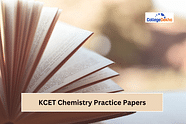
NEET Questions on Breathing and Exchange of Gases is one of the most important chapters for the
NEET 2025 Exam
. The total weightage of the NEET Questions on Breathing and Exchange of Gases with Solutions is 4%. That means it is anticipated that around 3 to 4 questions can be expected from this chapter. It is important to go through the NEET Questions on Breathing and Exchange of Gases so that aspirants can get an idea about the type of questions and the marks distribution for this section. As per the official
NEET Syllabus 2025
, chapters from both Classes XI and XII of the CBSE curriculum are included. The Breathing and Exchange of Gases is the 17th Chapter from Class XI. Aspiring candidates should make sure to regularly solve the previous year question papers and attempt mock tests to attempt the NEET Questions on Breathing and Exchange of Gases without any hurdles.
Important NEET Questions on Breathing and Exchange of Gases is one of the most complex chapters for the NEET Exam. Some of the important concepts from where NEET MCQ on Breathing and Exchange of Gases can be asked include the human respiratory system, Respiratory volumes, and capacities, Mechanism of breathing, Regulation of respiration, Exchange of gases, and Transport of gases. As per topper and expert suggestions, one of the most effective ways to prepare for the NEET Questions on Breathing and Exchange of Gases is to refer to the best books, learning materials, and previous year question papers. Read the article below to learn in detail about the NEET Questions on Breathing and Exchange of Gases, important questions, and how to prepare. Click here for all important MCQs on the Breathing and Exchange of Gases.
NEET MCQs on Breathing and Exchange of Gases
Candidates can refer to the questions below to generate an idea about the types of NEET Questions on Breathing and Exchange of Gases that are discussed below.
Q.1 In humans, what is true about RBCs?
- They transport about 80% of oxygen, and the remaining 20% is dissolved in blood plasma
- They transport 99.5% of oxygen
- About 20-25% of CO2 is carried by them
- They do not hold CO2
Answer: B
Explanation: About 99.5% of Oxygen and 20-25% of Carbon Dioxide (CO2) are transported and carried respectively by the Red blood cells (RBCs). The remaining 0.5% of oxygen is transported in a dissolved state. The rest of the CO2 is exhaled during respiration.
Q.2 Lungs are made up of air-filled sacs, the alveoli. They do not collapse even after forceful expiration, because of
- expiratory reserve volume
- inspiratory reserve volume
- residual volume
- tidal volume
Answer: C
Explanation: The residual volume keeps the alveoli inflated and prevents them from collapsing. It also creates a time gap between when oxygen is absorbed and when carbon dioxide is removed.
Q.3 Name the chronic respiratory disorder caused mainly by cigarette smoking
- Respiratory Alkalosis
- Respiratory Acidosis
- Asthma
- Emphysema
Answer: D
Explanation: Emphysema is a chronic obstructive pulmonary disease (COPD) that affects the lungs in human beings. In this condition, the walls of the alveoli in the lungs are damaged. Emphysema is mainly caused due to prolonged cigarette smoking.
Q.4 Which part of the respiratory system is responsible for exchanging gases with the bloodstream?
- Trachea
- Bronchi
- Alveoli
- Larynx
Answer: C
Explanation: The alveoli are tiny air sacs and are part of the respiratory system that exchange gases with the bloodstream. During breathing, oxygen passes from the alveoli into the blood, and carbon dioxide passes from the blood into the alveoli.
Q.5 Why does oxygen move through the alveolar blood capillaries of the lungs?
- Differences in the O2 tension and partial pressure of these chambers
- The partial pressure of CO2
- Union of O2 with haemoglobin
- All of the above
Answer: D
Explanation: Through the alveolar blood capillaries of the lungs, oxygen diffuses because of the differences in the partial pressure of oxygen and carbon dioxide. In red blood cells, oxygen combines with haemoglobin molecules.
Q. 6 Bulk of carbon dioxide (CO2) released from body tissues into the blood is present as
- carbamino-hemoglobin in RBCs
- 70% carbamino-hemoglobin and 30% as bicarbonate
- free CO2 in blood plasma
- bicarbonate in blood plasma and RBCs
Answer: D
Explanation: The majority of carbon dioxide (CO_{2}) released from body tissues into the blood is present as bicarbonate in the blood plasma and red blood cells (RBCs).
Q.7 An increase in lung ventilation rate is caused by which of the following conditions?
- Increase of CO2 content in inhaled air
- Addition of CO2 content in exhaled air
- Decrease of O2 content in exhaled air
- Reduction of O2 content in inhaled air
Answer: A
Explanation: When carbon dioxide levels in the blood rise, the respiratory centres are stimulated to increase the rate and depth of breathing to remove the excess carbon dioxide. This condition is called hypercapnia.
Q.8 Haemoglobin is bonded to carbon monoxide and, therefore cannot transport oxygen is called
- Carboxyhaemoglobin
- Reduced hemoglobin
- Carbamino Haemoglobin
- Methemoglobin
Answer: A
Explanation: When haemoglobin is bonded to carbon monoxide and cannot transport oxygen, it is called carboxyhemoglobin. This occurs when carbon monoxide (CO) binds to the haemoglobin in the blood, preventing oxygen from binding in the same locations.
Q.9 Which gas is responsible for the majority of oxygen transport in the bloodstream?
- Oxygen
- Carbon Dioxide
- Nitrogen
- None of the above
Answer: A
Explanation: Oxygen is the main gas that is responsible for the majority of O2 supply in the bloodstream. With the help of haemoglobin, 98% of the total oxygen supply in the bloodstream is responsible.
Q.10 Which muscle is primarily responsible for breathing in humans?
- Diaphragm
- Intercostal muscles
- Abdominal muscles
- None of the above
Answer: A
Explanation: The diaphragm is a large, dome-shaped muscle that separates the chest cavity from the abdominal cavity. When human beings inhale, the diaphragm contracts and flattens, which increases the size of the chest cavity and decreases the pressure inside the lungs.
Related Articles:
Candidates must make sure that they are referring to the best reference books and learning materials to prepare for the NEET Questions on Breathing and Exchange of Gases. The total number of Important NEET Questions on Breathing and Exchange of Gases to be asked in the exam is 3 to 4. Hence, candidates can easily score 24 to 28 marks from this chapter only. It would be foolish to skip the chapter for the NEET Exam. Regularly attending mock tests and solving previous year question papers are recommended by toppers to prepare for the NEET Questions on Breathing and Exchange of Gases. For more articles related to Nursing, Paramedical, and Medical, follow CollegeDekho.
Are you feeling lost and unsure about what career path to take after completing 12th standard?
Say goodbye to confusion and hello to a bright future!

Was this article helpful?





















Similar Articles
INI CET Round 1 Seat Allotment January 2026; Download Link, Steps to Accept and Upgrade Seat, Fee Details
NEET MDS 2026 Exam Day Instructions: Documents Required, Guidelines, Do's and Don'ts
What is the MBBS Admission Process for Foreign Nationals?
Can I do Physiotherapy after 12th with Commerce or Arts?
Government Jobs Available for BPT Graduates in India
Is BPT a good course option in India?